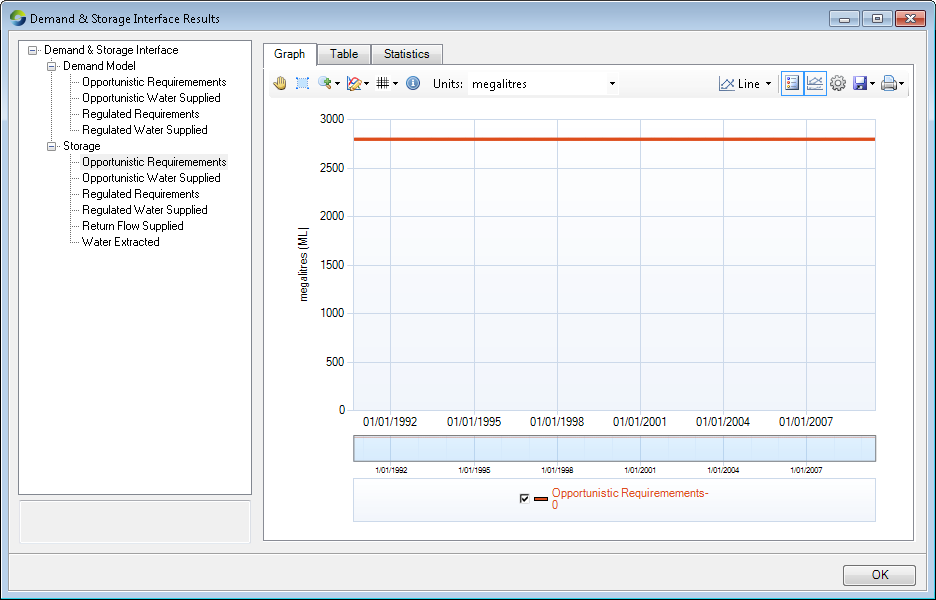Off Allocation node
teamcity (Deactivated)
asatheesh (Unlicensed)
Meryl McKerrow
The off-allocation flow sharing node is used to determine how much off-allocation flow is available in the river (at the node), as well as how to share this between the downstream water users that have licence shares. Off-allocation flows are those that are in excess of regulated requirements. They can be generated from unallocated tributary inflows downstream of storages, and from storage spills.
Off-allocation flow sharing is comprised of two major components: determining the total volume of water to share and the accounting and sharing of that water. It is triggered when the flow volume at an off-allocation node meets the defined criteria for an off-allocation flow sharing event. This event can be a proportion of the volume of water either above the threshold or above all regulated downstream requirements, which can then be shared between the water users who have an account at the node. A trigger is a condition that must be met in order to allow allocated water to become available.The main condition is the flow threshold, as described in the node’s parameters. Start and end season could also be considered a trigger.
An off-allocation node (OAN) is connected to a water user (via a supply point node), which may generate a request for off-allocation water. This can be met from either off-allocation or overbank flow. The OAN determines how much of the request can be met taking into consideration what may already have been met by other OANs in the system. It uses various parameters to determine whether off-allocation requests can be met:
- Off-allocation event starts and finishes using flow and date triggers;
- Total off-allocation volume available - the volume of water either above the threshold or above all order debit downstream requirements; and
- Share the off-allocation volume between accounts under that OAN. An account can be held downstream by storages, water users and an OAN immediately downstream.
These can be assigned while adding and configuring an OAN, which is explained next.
Note: An off-allocation system in Source works only if New rules based ordering system has been configured as the ordering approach in Edit » Ordering » Algorithm.... and if account based sharing is used (when the water user has been assigned a regulated account).
Adding an off-allocation system
You must have an existing Resource Assessment System (RAS) prior to defining an off-allocation system. Use the Resource Assessment Explorer to add an off-allocation system in Source. The resulting window is shown in Figure 1.
Figure 1. Resource Assessment Explorer (Configuring an off-allocation system)
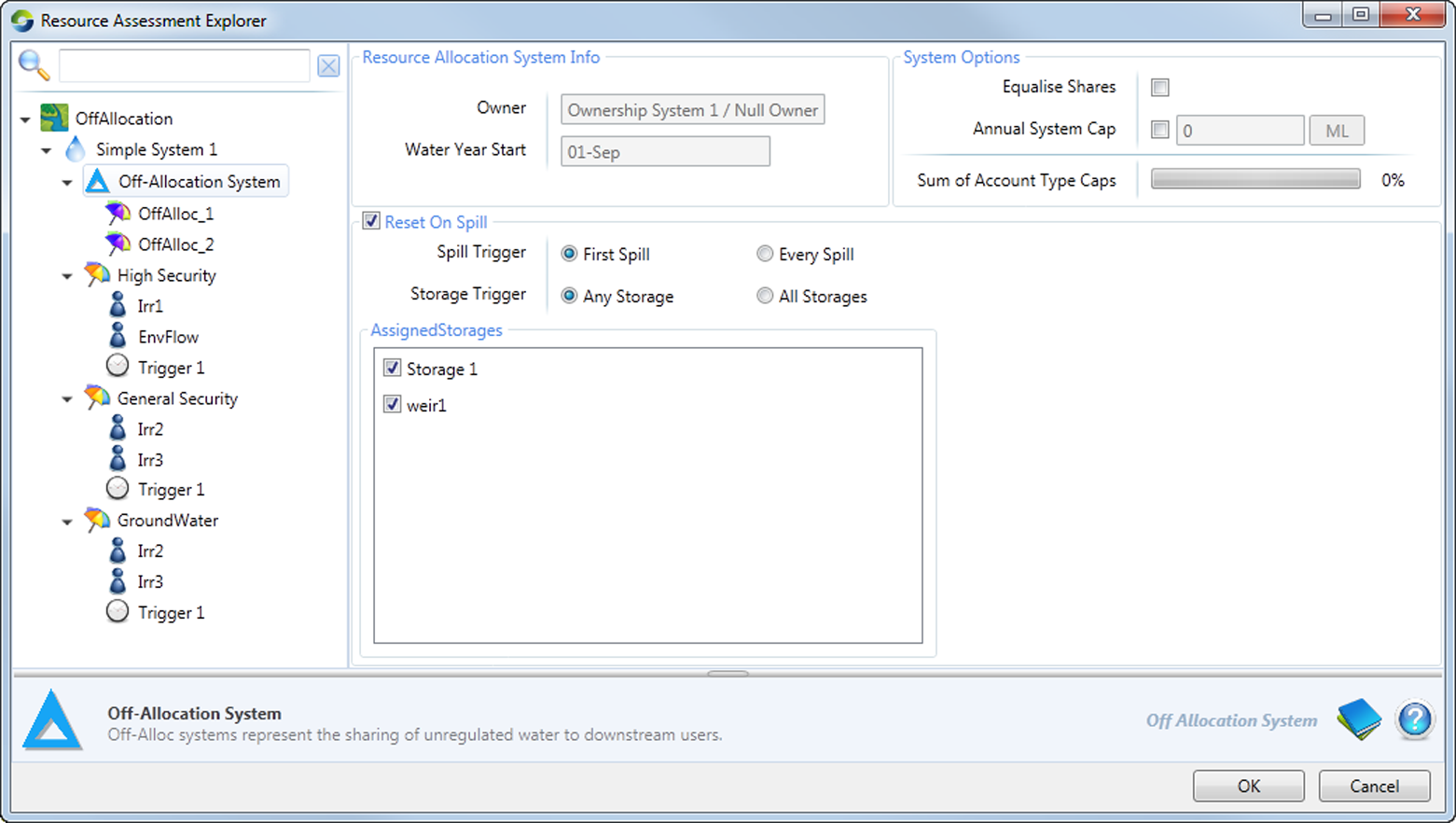
Define the following system level parameters for the off-allocation system:
- System options - These can be enabled if required. If Equalise Shares is enabled, the allocation of water at each priority level will initially be based on an attempt to equalise usage in proportion to shares. Users at that priority level have an equal usage to share ratio, then assignment of off-allocation water proceeds, as normal, in proportion to shares. If Equalise Shares is not enabled, allocation occurs in proportion to shares, subject to the priority levels defined in the Volume Allocation Table. Annual System Cap is an optional volumetric cap on usage for the off-allocation system. Usage is reset to zero automatically at the commencement of each water year;
- Threshold options - For all off-allocation account types, thresholds are defined to determine when and what volume of off-allocation water is available. The meaning of a threshold is defined for the river system as a whole. In First spill, the relevant account balances will only be reset if spilling was not occurring at the previous time-step. In Every spill, the relevant account balances will be reset each time a selected storage spills. Storage Trigger defines if accounts are reset if any of the assigned storage spills or only when all selected storages are spilling. This can be specified in the node’s feature editor (Feature Editor 1) as well; and
- Reset on spill - This is used in conjunction with the storage/s in a scenario. When a selected storage spills in a time-step, the Usage for all accounts in the off-allocation system are reset to ‘0’.
Adding an account type
For each OAN created in the model, you must also create an account type under the off-allocation system. Right click on the desired off-allocation system and choose Add Account Type. This opens the window shown in Figure 2, where you can enter the specific rules that apply to that OAN.
Figure 2. Resource Assessment Explorer (Off-allocation system, Account type, configuration)
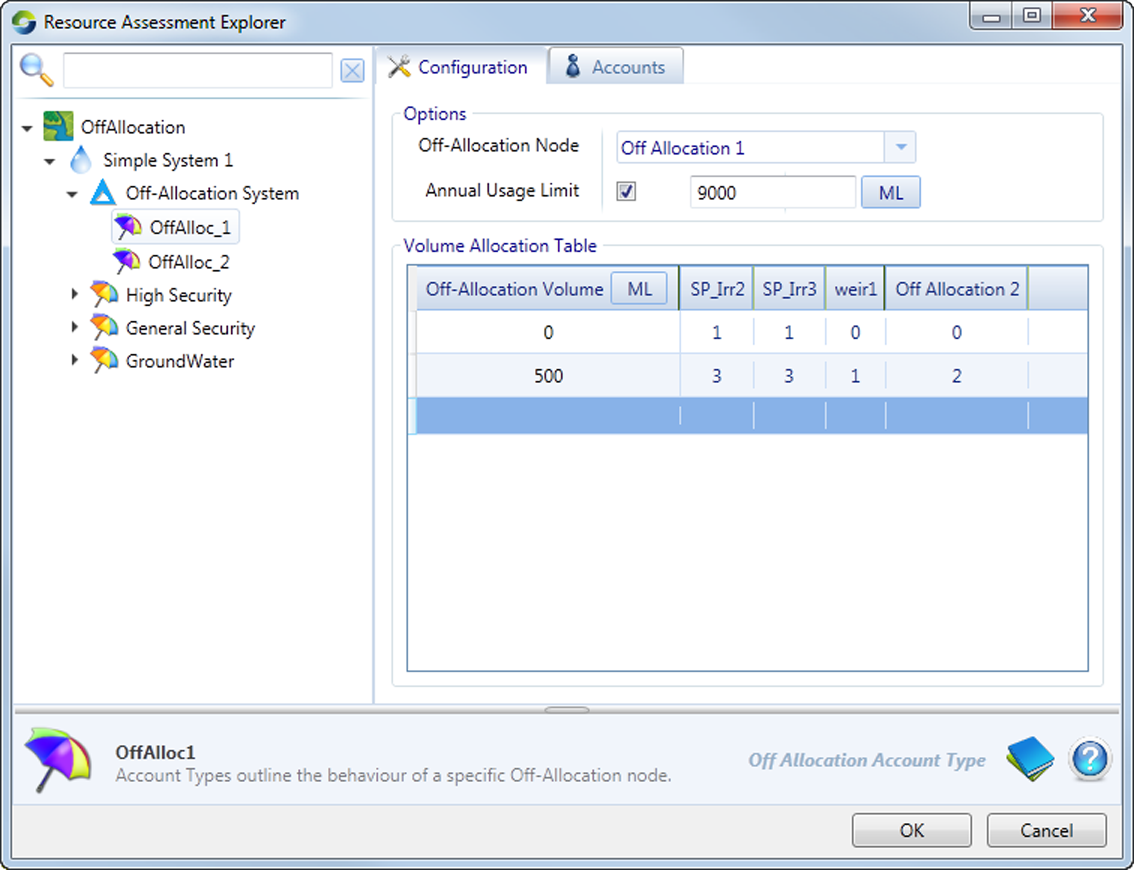
You must define the OAN before specifying the account type. Annual Usage Limit is an optional volumetric cap on combined usage of all accounts in this off-allocation account type. The cap is assigned to accounts based on shares. Usage on accounts is reset to 0 automatically at the commencement of each water year.
The Volume Allocation Table has to be configured before any off-allocation water will be made available to water users. This table defines how off-allocation water is shared between supply points in the reach, any storages in the reach and downstream of the OAN.
The Accounts tab shows a table which lists all supply points which have a share in that OAN system and the details for those accounts can be entered. If any downstream OAN nodes or storages are also part of the OAN system, these are also configured here.
Figure 3. Resource Assessment Explorer (Off-allocation system, Accounts)
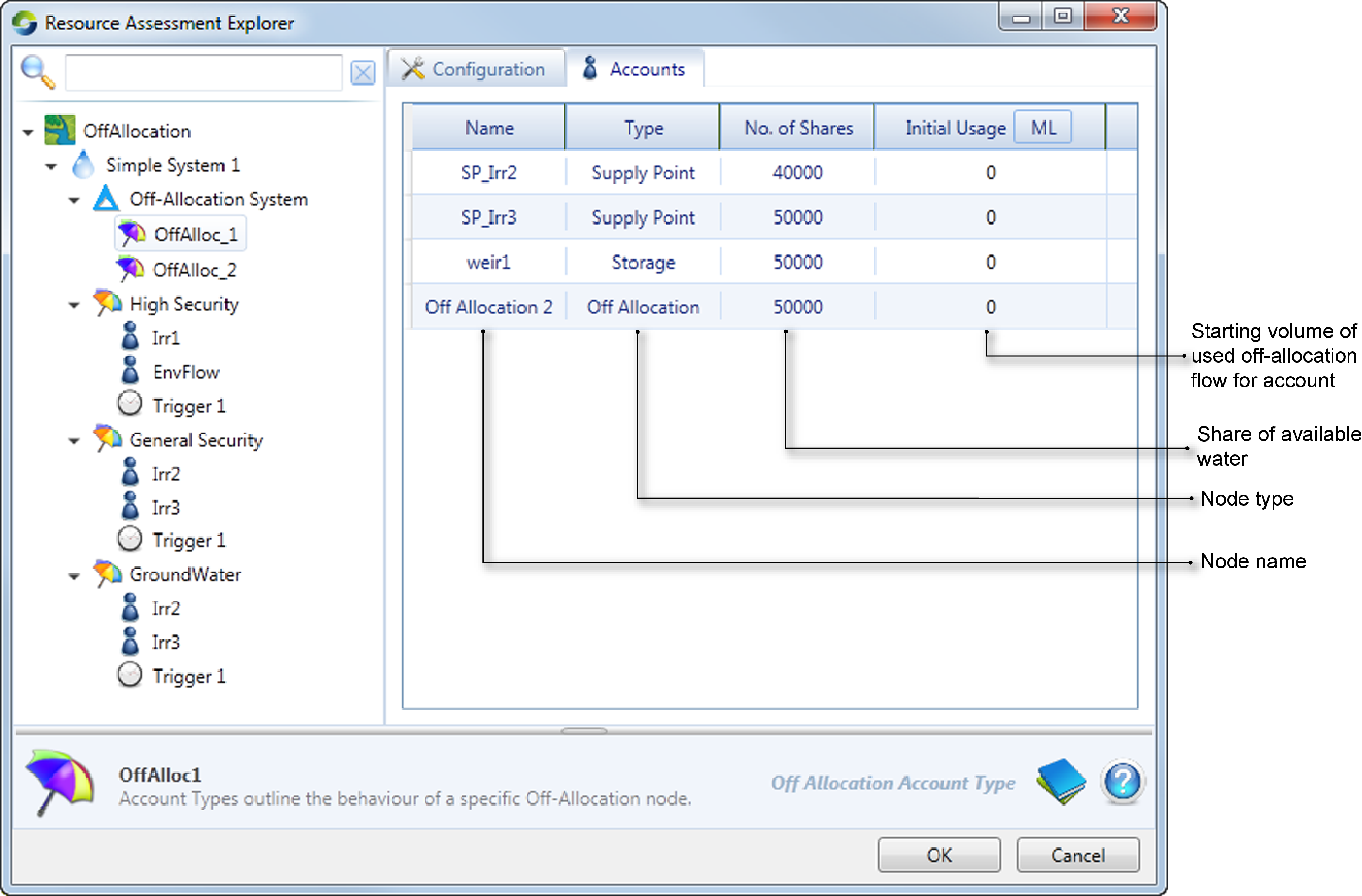
Viewing an off-allocation system
Double click the off-allocation node to open its feature editor (Figure 4).
Figure 4. Off-Allocation node
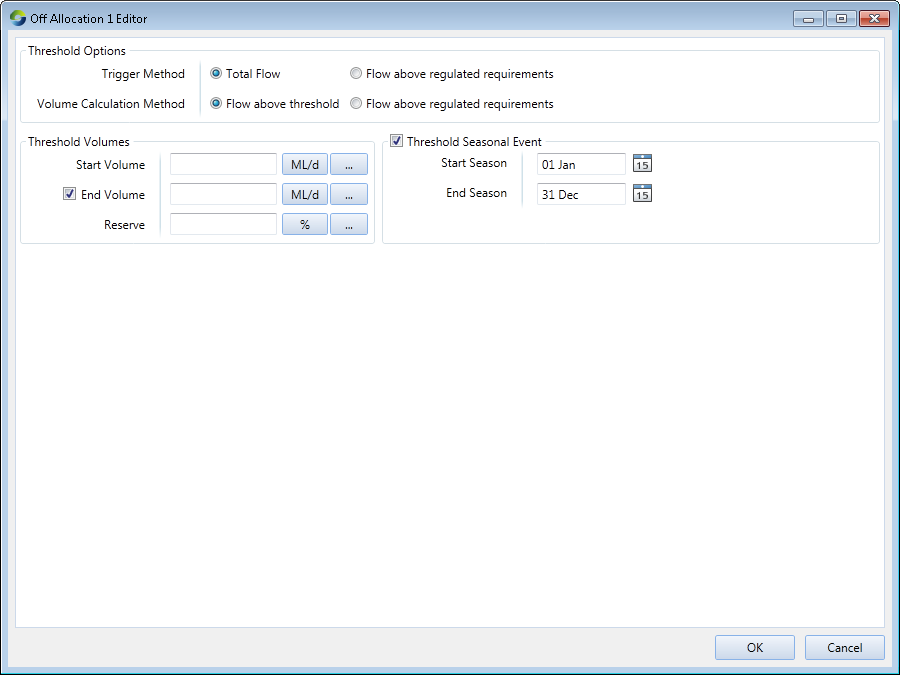
Trigger Method specifies how an off-allocation event is triggered for that off-allocation reach. For Total Flow, an off-allocation period will only be triggered if the flow at the node exceeds the threshold defined. For flow above regulated requirements, an off-allocation period is triggered if the flow at the node exceeds the volume required for all downstream order debit orders. Volume Calculation Method specifies how the volume of off-allocation water is calculated. For Flow above threshold, the threshold is not available for off-allocation. For Flow above regulated requirements, any flow above the regulated requirement is made available. If a threshold value has been defined, this can be included in off-allocation volume once the threshold has been reached.
The remaining parameters are:
- Start and End volume - Defines the start and end flow volumes at the node, the flow above this threshold may trigger an off-allocation flow event. The default units are ML per day, but you can change this using an expression editor;
- Reserve - The percentage of off-allocation flow which cannot be allocated; and
- Threshold Season Event - The time period when the off-allocation flow event may occur (optional);
Multiple OANs in a system
In the instance where one OAN orders from another OAN, the first OAN will act much the same as a normal user - ie supply point. The main differences are that the OAN users:
- Will not be capped by account type caps; and
- They can use more then they are allocated.
An example of this is shown in Figure 5. For off-allocation volumes equal to or above 100 ML, equal priority is given to supplying requirements of irrigators 1 and 2 and all downstream users. Note that the latter has been configured by making the downstream OAN (OAN2) equal priority to the irrigators in the current reach.
Figure 5. Resource Assessment Explorer (Off-allocation system, multiple OANs)
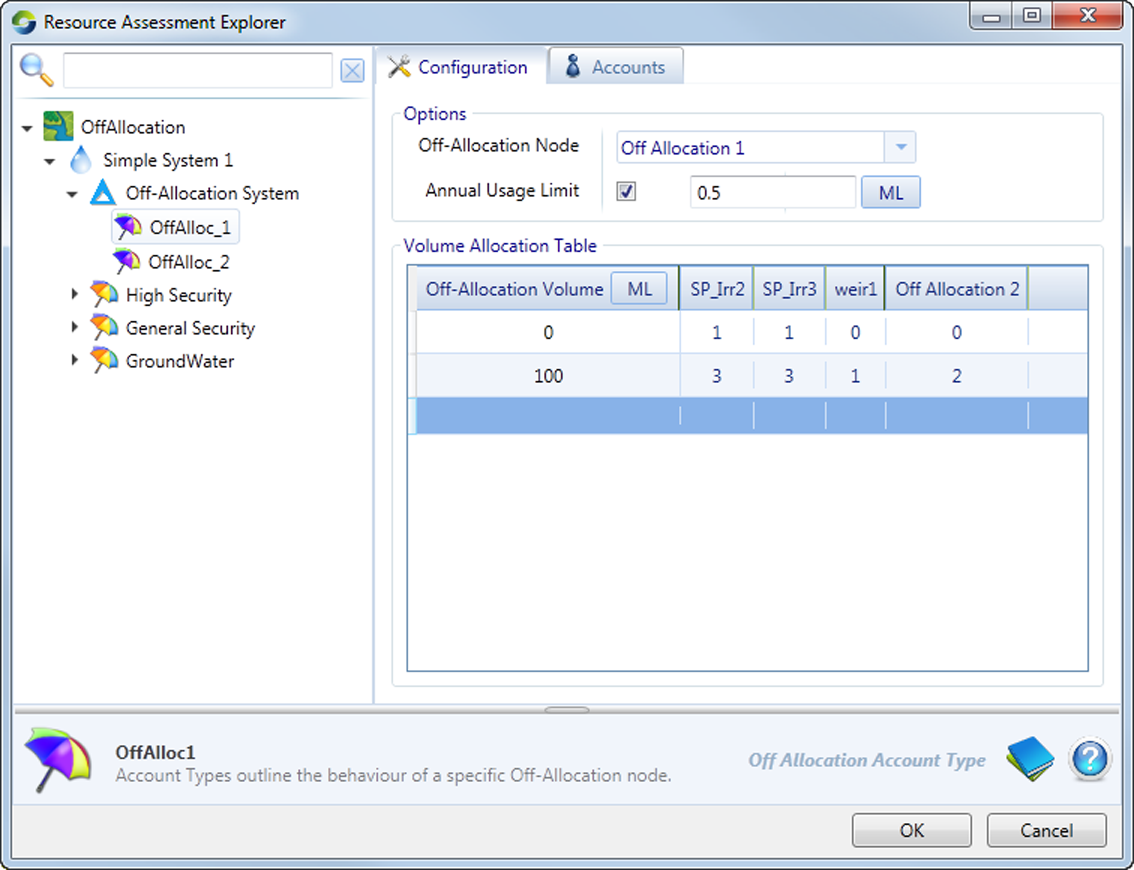
The OAN has been assigned 1500 shares. If sharing of off-allocation water with downstream reaches is not required then the downstream OAN can be assigned zero shares. Otherwise, the shares should be set to the sum of all accounts in downstream reaches for which sharing is required. For example, if equal sharing was required between OAN1 and six downstream reaches, then the total shares of accounts in the six downstream reaches should be entered as the number of shares assigned to OAN2.
Deleting a node
If you delete a node or link that uses off-allocation node accounts, you must make changes at each node to accommodate this change. Additionally, when deleting an OAN, a warning message will appear indicating that you are about to remove account type settings for off-allocation systems. After confirmation, you must delete all off-allocation account types in any system that are associated with the OAN.
Evaluation of results
You can view the effects of off-allocation at various nodes in a model in the Recording Manager:
- Check the declaration of off-allocation water using the Off Allocation Flow Volume attribute for an OAN;
- Check the off-allocation order and off-allocation water extracted to fill the water user storage. Select the Demand & Storage Interface attribute of a water user node and view the Opportunistic Requirement of the system. This can be met from off-allocation water as well as other sources such as overbank flow. An example of this is shown in Figure 6; and
- Compare the sharing of off-allocation water between water users using the Off Allocation Flow Volume attribute for various water user nodes in the model.
Figure 6. Off-allocation system, Opportunistic requirement
